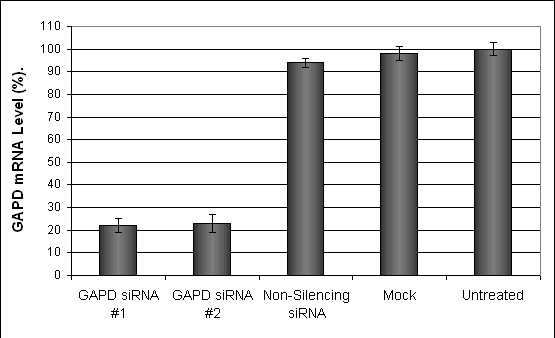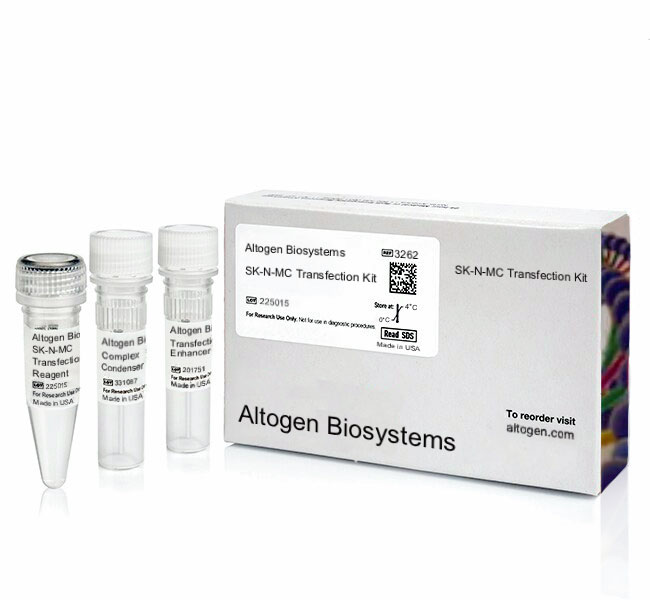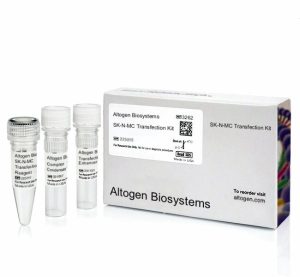Description
Purchase Orders: Click “Add to Cart” button to order, then email PO to orders@altogen.com.
Product Availability: In Stock.
Transfection Reagent for SK-N-MC Cells (Neuroblastoma Cells)
-
Two component formulation enhances lipid mediated transfection efficiency
-
Optimized easy-to-use transfection protocol provided for transfection of siRNA, DNA, mRNA, and microRNA
-
Kit includes Transfection Enhancer reagent and recommended transfection protocol
-
High transfection efficacy in the presence of serum
-
Expand your RNAi application with a reagent optimized for delivery of both siRNA and plasmid
-
Reproducible transfection results
-
Download in vitro SK-N-MC transfection protocol: [PDF]
- Download SK-N-MC CRISPR/Cas9 transfection protocol: [PDF]
- Download PowerPoint presentation for SKNAS cells transfection kit: [PPT]
- UPC/GTIN/EAN: 860002089798
-
Brand: ALTOGEN®, developed and manufactured by Altogen Biosystems
Transfection Efficiency:
Reagent exhibits at least 76% transfection efficiency of siRNA delivery. Transfection efficiency was determined by RT-PCR
Product Description:
High efficiency transfection kit for SKNMC cells, human prostate cancer cell line. Transfection reagent, complex condenser and transfection enhancer reagent.
Transfection Protocol and SDS:
Download Altogen Biosystems SK-N-MC Transfection Protocol: [PDF]
Download SDS: [PDF]
SK-N-MC Cell Line:
SK-N-MC is a human neuroblastoma cell line that was originally derived from a tumor in the adrenal gland of a child with neuroblastoma. Neuroblastoma is a type of cancer that develops from immature nerve cells and most commonly affects young children. SK-N-MC cells are commonly used in research to study neuroblastoma and the mechanisms underlying its development and progression. These cells are known to exhibit many of the characteristics of neuroblastoma, including the ability to form tumors in animal models and the expression of specific molecular markers associated with neuroblastoma. Researchers have used SK-N-MC cells to investigate a wide range of topics related to neuroblastoma, such as the role of specific genes and signaling pathways in cancer development, the effects of different treatments on cancer cells, and the interactions between cancer cells and the immune system. According to the American Brain Tumor Association, approximately 80,000 new cases of brain tumors are diagnosed annually among adults. Nearly one-third of them are malignant, and 17,000 of patients will die annually. Besides, a brain tumor is the most common pediatric malignancy and the primary cause of cancer deaths in children. Human cell line models have proven to be indispensable tools for the identification of any potential limitations and finding new treatment options for brain cancer patients. SK-N-MC was derived in 1971 from a 14-year-old girl. The original paper indicated it came from the supraorbital metastasis of neuroblastoma. However, SK-N-MC is now thought by many to have originated from an Askin’s tumor related to Ewing’s sarcoma, which is the morphologically similar to neuroblastoma. Research showed FLI1-EWS gene fusion, the pathological change in Ewing’s sarcoma and Askin’s tumor, in the cells. SK-N-MC are adherent, fibroblast-like cells that grow as monolayers. The cell line is a pseudodiploid female (XX) that has chromosome counts in the diploid range. SK-N-MC has a modal chromosome number of 46. Normal chromosomes N3 and N10 are absent, and many are monosomic. Normal chromosome N8 is frequently tetrasomic. The activity of dopamine-beta-hydroxylase is moderate, and formaldehyde-induced fluorescence indicative of intracellular catecholamines. SK-N-MC cells exhibit an epithelial cell type and are neuroblastoma cells, which makes them useful for research related to brain cancers. The SK-N-MC neuroblastoma cell line has a higher cholinergic activity relative to other NB cell lines, and this coupled with its tumorigenicity make it a powerful research tool. Altogen Biosystems offers transfection kits for the SK-N-MC cell line.
Data:

Figure 1. GAPD mRNA levels were quantified using real-time PCR in the SKNMC cells transfected with siRNAs targeting GAPD or non-silencing siRNA. Forty-eight hours post-transfection, the cells were harvested and analyzed by real-time PCR for GAPD mRNA expression levels. Data were normalized against the 18S rRNA signal. Control samples were either mock-transfected or untreated. Values are normalized to untreated sample. Data are means ± SD (n=5).

Figure 2. Protein expression of GAPDH in SK-N-MC cells. DNA plasmid expressing GAPDH or siRNA targeting GAPDH were transfected into SK-N-MC cells following Altogen Biosystems transfection protocol. At 72 hours post-transfection the cells were analyzed by Western Blot for protein expression levels (normalized by total protein, 10 µg of total protein loaded per each well). Untreated cells used as a negative control.
Selected in vivo transfection product citations (ALTOGEN® IN VIVO Transfection Kits used in the following publications):
- Nature. 2008 454(7203):523-7. Innate immunity induced by composition-dependent RIG-I …Saito et al [PDF]
- Am J Pathology. 2010 177(4):1870-80. Role of ocular complement factor H in a murine model … Lyzogubov et al [PDF]
- Nature Biotechnology. 2011 29(4):341-5. Delivery of siRNA to the mouse brain by … Alvarez-Erviti et al [PDF]
- Cancer Research. 2011 71(15):5144-53. Inhibition of miR-193a expression by… Iliopoulos et al [PDF]
- RNA. 2010 16(11):2108-19. RNase L releases a small RNA from HCV RNA that refolds … Malathi et al [PDF]
- Gastroenterology. 2011 141(2) Differential type I interferon-mediated autophagic trafficking … Desai et al [PDF]
- PLoS Pathog. 2014 10(10) Exosomes from hepatitis C infected patients transmit HCV … Bukong et al [PDF]
Altogen Biosystems is a life sciences company that offers cell type-specific and pre-optimized transfection products, elecroporation kits, and in vivo delivery reagents. Advanced formulation of reagents and optimized transfection protocols provide efficient intracellular delivery of protein, DNA, mRNA, shRNA and siRNA molecules. Read more about transfection technology at Altogen’s Transfection Resource. Altogen Labs provides safety and efficacy preclinical research services. GLP-compliant studies for IND applications, and drug development, including over 90 in-house validated xenograft models, safety toxicology, etc (visit AltogenLabs.com).
Volume Options:
- 0.5 ml (Catalog #3261)
- 1.5 ml (Catalog #3262)
- 1.5 ml CRISPR (Catalog #2195)
- 8.0 ml (Catalog #7087)
Purchase Orders: Click “Add to Cart” button to order, then email PO to orders@altogen.com.
Product Availability: In Stock.






